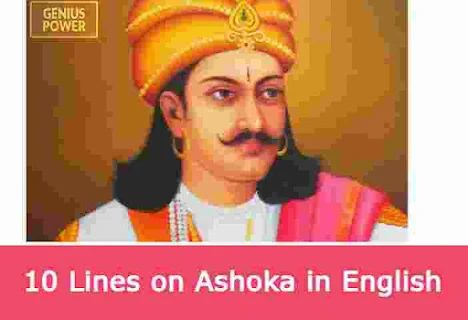10 Lines on Ashoka in English
- Ashoka was the famous ancient Indian ruler.
- He is the son of Bindusara.
- He became king after the death of his father.
- He was responsible for spreading Buddhism throughout
- India. He ruled from 265 or 273 BC to about 238 or 232 BC.
- Ashoka spent years fighting to conquer Kalinga.
- During Kalinga war thousands of people were killed.
- He regretted all the violence and suffering.
- He had caused during the Kalinga war.
- He gave up fighting wars and focused on spreading Buddism.
10 Lines on Ashoka in English
1. Ashoka was an Indian emperor of Maurya Dynasty.
2. He was popularly known as 'Ashoka the Great'.
3. Ashoka was born in Pataliputra.
4. He was the son of Bindusara.
5. He became king after the death of his father.
6. Ashoka ruled for 40 years.
7. The word Ashoka means 'Shockless'.
8. He accepted Buddhism as his religion.
9. Ashoka promoted the spread of Buddhism.
10. Ashoka spent years fighting to conquer Kalinga.
10 Lines on Ashoka in English
- Ashoka the great was the son of king bindusara and queen subhadrangi.
- Ashoka was born in pataliputra around 304 bc.
- He was the great son of the founder of maurya dynasty chandragupta maurya
- The kalinga state was captured by Chakravarti
- Ashoka in his eighth year of rajaship.
- He converted him self to buddiem after the war of kalinga.
- Ashoka the great ruled india for 243 bc to 232 bc.
- Askoka the great died in 232 bc in taxila
- The place where ashoka war is "kalinga"
- Ashoka full name is ashoka maurya
Ashoka Essay for Students and Children in English
An impeccable warrior general and a shrewd statesman, Ashoka was very popular. He was a fearsome hunter, and according to a legend, killed a lion with just a wooden rod.
His growing popularity made his elder brothers wary of his chances of being favored by Bindusara to become the next emperor.
The eldest of them, Prince Sushim, persuaded Bindusara to send Ashoka to Takshashila to quell an uprising. But as news of Ashoka’s visit with his army trickled in, he was welcomed by the revolting militias and the uprising ended without a fight.
Some more incitements from Sushim led his father to send Ashoka into exile. So, he went to Kalinga and stayed there incognito for many years. Meanwhile, there was a violent uprising in Ujjain.
Emperor Bindusara summoned Ashoka back. Ashoka went to Ujjain and was injured in the ensuing battle, but his generals continued the fight. Ashoka was treated in hiding by Buddhist monks and nuns.
This is where he first learnt the teachings of Buddha. In the meantime, Ashoka’s father was taken ill. A clique of ministers lead by Radhagupta, summoned Ashoka to take the crown.
As the Buddhist lore goes, in a fit of rage, Ashoka attacked Patliputra and killed all his brothers and threw their bodies into a well.
At this stage, many called him ‘Chandashoka’ meaning murderer and heartless Ashoka. Brave and full of valour, after ascending the throne, Ashoka expanded the boundaries of his empire.
At this point, he was called ‘Chakravarti’ which means ‘he for whom the wheel of law turns’.
However, the conquest of Kalinga turned the wheel of fortune for him. As the tale goes, Kalinga gave official refuge to Ashoka’s enemy (probably one of his brothers).
This enraged Ashoka and he asked Kalinga’s royalty to submit before his supremacy. When they defied this dictate, Ashoka sent one of his generals to make Kalinga submit to his supremacy.
However, Ashoka’s general and his forces were completely routed. Baffled by this defeat, Ashoka attacked with the greatest invasion ever recorded in Indian history till then.
The whole of Kalinga was plundered and destroyed. After this devastation, Ashoka was left speechless.
While he was walking through the battlefields of Kalinga after his conquest, he saw thousands of dead bodies lying there and the wailing of people.
He was constantly haunted by his deeds in Kalinga. The repentance at the brutality of the conquest led him to embrace Buddhism.
He undertook a 256-day pilgrimage to holy places of Buddhism in North India.
From that point, Ashoka, who had been described as ‘the cruel Ashoka’ (Chandashoka) started to be described as ‘the pious Ashoka’ (Dharmashoka).
He propagated the Vighajjavada School of Buddhism and preached it within his domain and worldwide from about 250 BC.
Emperor Ashoka, undoubtedly, has to be credited with the first serious attempt to develop a Buddhist policy.
He built thousands of stupas and viharas for Buddhist followers (about 84,000 such monuments were built).
The stupas of Sanchi are world-famous and the stupa named Sanchi Stupa I was built by Emperor Ashoka.
During the remaining period of Ashoka’s reign, he pursued an official policy of non-violence called ahimsa.
The unnecessary slaughter of animals was immediately abolished. Moreover, rest houses were built throughout the empire to house travelers and pilgrims free of charge.
Egalitarianism became a norm for society. Slavery was non-existent in ancient India.
Ashoka amalgamated Buddhism with material issues of concern, thus fulfilling Buddha’s wish of alleviation of people’s sufferings.
To that effect, Ashoka had wells dug, irrigation canals and roads constructed. Other than rest houses, he also built hospitals, gardens and plantations of herbs.
Also read: 10 Lines on Mahabharata in English
Also read: 10 Lines on Rabindranath Tagore
Also read: 10 Lines on Sarojini Naidu
Also read: 5 Lines on Firefighter
Also read: Essay on Lighthouse in English
THANK YOU SO MUCH

can you give me the information of Ashoka 's dress
ReplyDelete